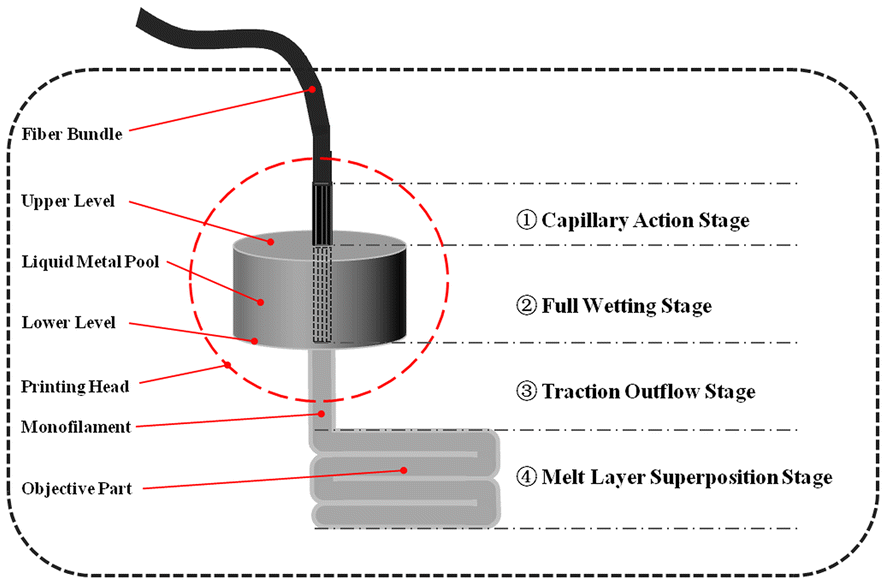Of additive manufacturing’s (AM) unique strengths is the ability to process metal more easily than is achievable with subtractive manufacturing, which has the added benefit of producing parts with unique geometries. In addition to opening up the processing of difficult-to-work-with materials, such as refractory metals, AM is making it possible to work with metal matrix composites (MMCs). A study published in the Chinese Journal of Mechanical Engineering documents one research team’s approach to 3D printing MMCs in order to combine the disparate properties of metals and reinforcement fibers.
The researchers, who hail from Shaanxi Engineering Research Center for Rapid Manufacturing Technology, combined tin-lead with carbon fiber in order to explore the possibilities of taking advantage of lead’s radiation shielding properties on the one hand and the strength of carbon fiber on the other. At the same time, the study sought to showcase the ability to 3D print with lead, previously difficult to achieve due to lead’s wettability (inability to stick to solid surfaces when in liquid form).
To achieve this goal, the research team relied on liquid tin-lead which has better wettability. Via a process dubbed fiber traction printing (FTP), carbon electroplated with nickel and copper is fed into an extruder where it saturated with molten tin-lead and printed using a material extrusion process similar to those seen in existing composite 3D printers from Markforged, Anisoprint and Desktop Metal.
The researchers were able to make a number of observations about the technology. For instance, the researchers were unable to theoretically calculate how to achieve morphological uniformity due to the surface tension of liquid metal. However, the team was able to determine a practical relationship between printing velocity and uniformity of deposition. Though carbon fiber with greater electroplating exhibited no observable defects, it also exhibited less wettability between the liquid metal and the fiber, and the layers were thicker.

Monofilament morphology of specimens at the printing velocity of (a) 1 mm/s, (b) 2 mm/s, (c) 3 mm/s, and (d) 4 mm/s and wire feeding of 10/100, 20/100, 30/100, 40/100. Image courtesy of Chinese Journal of Mechanical Engineering.
The study demonstrated that, by combining liquid metal with carbon fiber, it is not only possible to mold liquid metal into desired shapes but also improve the mechanical properties of low melting alloys, such as tin-lead. The tensile strength of the tin-lead material was increased from just 33.3 MPa to 235.2 MPa, when using carbon fiber with a 3-μm layer of electroplating. The fiber volume was increased when the electroplating layer was increased as well.
The ability to 3D print lead could result in unique parts that require radiation shielding, such as spacecraft. The team believes that the FTP process could be extended to other MMCs, such as carbon fiber-aluminum and carbon fiber-magnesium.
Due to the fact they are almost always more expensive than the traditional material that they are intended to replace, MMCs are typically reserved for high-end applications, such as high-performance cutting tools (tungsten-carbide), sports cars (carbon fiber and silicon carbide, aluminum with boron carbide), electronics (copper-silver and diamond, aluminum-graphite), and aerospace (silicon carbide fibers and titanium). Similarly, due to issues of scale, AM is also often reserved for high-end, short run applications. In turn, we might expect these two areas to overlap a good deal as the ability to print MMCs advances.
So far, research into printing MMCs is being performed at a number of institutions, including California State University, where a team is 3D printing titanium with ceramics; AGH University, where Inconel 625 and tungsten carbide are being combined; and Deakin University, where boron nitride and titanium are being blended.
Though it naturally takes time for this sort of research to go beyond the walls of the lab, there is little doubt that existing commercial entities are likely working on similar technology—especially if those businesses are already dealing in both fiber composites and metals, as is the case with Desktop Metal and Markforged.
Subscribe to Our Email Newsletter
Stay up-to-date on all the latest news from the 3D printing industry and receive information and offers from third party vendors.
You May Also Like
Gorilla Sports GE’s First 3D Printed Titanium Cast
How do you help a gorilla with a broken arm? Sounds like the start of a bad joke a zookeeper might tell, but it’s an actual dilemma recently faced by...
Nylon 3D Printed Parts Made More Functional with Coatings & Colors
Parts 3D printed from polyamide (PA, Nylon) 12 using powder bed fusion (PBF) are a mainstay in the additive manufacturing (AM) industry. While post-finishing processes have improved the porosity of...
$25M to Back Sintavia’s Largest Expansion of Metal 3D Printing Capacity Since 2019
Sintavia, the digital manufacturing company specializing in mission-critical parts for strategic sectors, announced a $25 million investment to increase its production capacity, the largest expansion to its operations since 2019....
Velo3D Initiates Public Offering in a Bid to Strengthen Financial Foundations and Drive Future Growth
Velo3D (NYSE: VLD) has been among a number of publicly traded 3D printing firms that have attempted to weather the current macroeconomic climate. After posting a challenging financial report for 2023,...

































